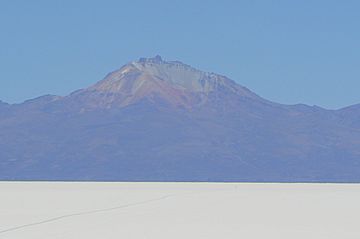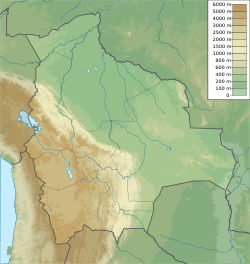Tunupa facts for kids
Quick facts for kids Tunupa |
|
|---|---|

Tunupa and Salar de Uyuni.
|
|
| Highest point | |
| Elevation | 5,321 m (17,457 ft) |
| Prominence | 1,601 m (5,253 ft) |
| Listing | Ultra |
| Geography | |
| Location | Potosí Department, Bolivia |
Tunupa is a sleeping volcano in the Potosí Department of southwestern Bolivia. It is also known as a dormant volcano, meaning it has not erupted for a long time but could erupt again.
This huge mountain stands on the northern side of the Salar de Uyuni, which is a giant salt flat. Tunupa is very tall, reaching about 5,321 m (17,457 ft) high. It is located on the Bolivian Altiplano, a high plateau in the Andes mountains. Tunupa was active a very long time ago, during the Pleistocene Ice Age. Most of the volcano was built by lava flows that erupted over a million years ago. In the past, large glaciers also formed on the mountain.
About halfway up Tunupa, there is a cave where several ancient mummies have been found. At the base of the volcano, you can find an old village and a unique "salt hotel."
Contents
Where is Tunupa Located?
Tunupa is found in Bolivia, right in the middle of the Altiplano. It is like a big finger of land reaching into the Salar de Uyuni, which surrounds the volcano on its southern side. The volcano is part of the Salinas de Garci-Mendoza area. Small towns like Ayque, Coquesa, and Jirira are located on its southern slopes.
How Tunupa Was Formed
Tunupa is a type of volcano called a stratovolcano. It rises about 1.8 kilometres (1.1 mi) above the land around it. The top of the volcano has been changed by hot water and gases, and its old crater has been worn down by wind and rain. You can see rocky peaks that are what's left of the old lava channels.
On its eastern side, some smaller lava domes formed on top of the older lava flows. On the northern side, you can find deposits from pyroclastic flows, which are fast-moving currents of hot gas and volcanic rock. Over time, erosion and glaciers have created a layer of rock and dirt that covers much of the volcano's base.
Tunupa's Glacial Past
Today, there is no permanent ice on Tunupa because the area is too dry. However, in the past, the mountain had large glaciers. These glaciers flowed down the valleys to elevations as low as 3,650–3,700 metres (11,980–12,140 ft). Later, smaller glaciers formed in the same valleys. You can still see signs of these glaciers, like smooth rocks with scratches (called glacial striae) and large piles of rock and dirt left behind by the ice (called moraines).
Scientists believe Tunupa had at least three periods of glaciation. One of the earliest ice advances happened about 160,000 years ago. Another period of ice might have happened around 15,000 years ago, possibly when a large lake called Lake Tauca existed nearby. The most recent ice period occurred during a cold time known as the Younger Dryas.
The southern slopes of Tunupa show old shorelines from huge lakes that once covered the Altiplano. These lakes include Lake Minchin and Lake Tauca. You can find old algae crusts, stromatolites (rocky structures made by tiny living things), and old river deltas at these shorelines. Tunupa was actually an island in Lake Tauca when it was at its biggest! It is thought that the evaporation from these large lakes helped the glaciers on Tunupa grow bigger by increasing rainfall.
What Tunupa is Made Of
Tunupa is mainly made of volcanic rocks called andesite, trachyandesite, and trachydacite. These rocks are rich in a mineral called potassium. The rocks contain small crystals of minerals like amphibole, biotite, clinopyroxene, and plagioclase. The lava domes on the volcano are made of a more silica-rich type of rock than the main volcano.
Climate Around Tunupa
The average temperature in a nearby city, Oruro, is about 9.5 °C (49.1 °F). As you go higher up Tunupa, the temperature drops to around 0 °C (32 °F) at 4,800 metres (15,700 ft). However, the region is very dry, with less than 200 millimetres per year (7.9 in/year) of rain. This dry climate is why glaciers do not form on Tunupa today.
When Tunupa Last Erupted
Scientists have studied the rocks from Tunupa to find out when it was active. Early studies suggested it erupted between 2.5 and 1.8 million years ago. More recent studies show eruptions happened between 1.55 and 1.40 million years ago. There are even some signs of activity as recent as 440,000 years ago. The main part of the volcano formed first, and the smaller lava domes appeared later. Today, Tunupa is considered an extinct volcano, meaning it is very unlikely to erupt again.
Tunupa in Legends
In the legends of the Aymara people, Tunupa is seen as a powerful spirit or god. Many stories about Tunupa are connected to how the famous Salar de Uyuni salt flat was formed.
See also
 In Spanish: Volcán Tunupa para niños
In Spanish: Volcán Tunupa para niños
- List of volcanoes in Bolivia
- List of Ultras of South America
- Altiplano Region
- Tittivilla
Images for kids
-
Tunupa Volcano, Bolivia from the International Space Station



